Welcome to the number lines worksheets page where jumping around is encouraged. This page includes Number line worksheets for learning about the ordinality of numbers and for use as a math aid.
Most Popular Number Line Worksheets this Week
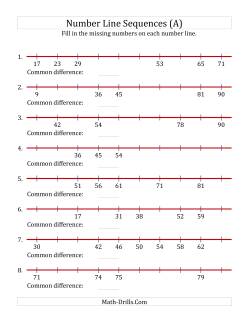

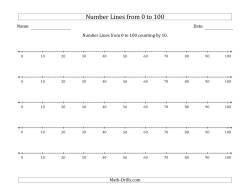

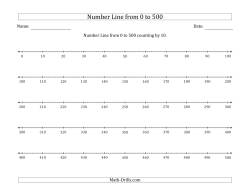
Counting on Number Lines
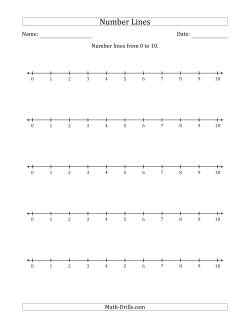
Each one of these pages includes number lines that increase by 1 for every tick. Various activities are possible, from learning how to count to using these number lines for adding/subtracting. There is no specific activity designated for these number lines, they are printables that you can use as you see fit.
-
Number Lines with Scales from 0 to 10 Counting by 1 Number Lines with Scales from 1 to 10 Counting by 1 Number Lines with Scales from 0 to 15 Counting by 1 Number Lines with Scales from 1 to 15 Counting by 1 Number Lines with Scales from 0 to 25 Counting by 1 Number Lines with Scales from 1 to 25 Counting by 1 Number Lines with Scales from 0 to 50 Counting by 1
Also called skip counting, counting by numbers other than 1 is a useful skill for students to learn as it helps them mentally calculate the answers to operations without the use of a pencil. These printables can be used for a variety of math activities that involve numbers including learning how to skip count, learning multiplication and other operations, or averaging two numbers. The number lines in this section include ticks for all numbers, but only the target interval is labeled.
-
Counting by 2 on Number Lines from 0 to 20 Counting by 2 on Number Lines from 0 to 40 Counting by 3 on Number Lines from 0 to 30 Counting by 3 on Number Lines from 0 to 60 Counting by 4 on Number Lines from 0 to 40 Counting by 4 on Number Lines from 0 to 80 Counting by 5 on Number Lines from 0 to 50 Counting by 5 on Number Lines from 0 to 100 Counting by 6 on Number Lines from 0 to 60 Counting by 7 on Number Lines from 0 to 70 Counting by 8 on Number Lines from 0 to 80 Counting by 9 on Number Lines from 0 to 90 Counting by 10 on Number Lines from 0 to 100
Continuous number lines allow for a larger range for extension activities that require larger numbers. The number at which each line ends also starts the next line, so if you wanted something more continuous, you could cut and overlap and paste into one long strip of paper. Activities such as multiplying two-digit by one-digit numbers and looking for patterns can be accomplished with these number lines.
-
Counting by 1 on a Continuous Number Line from 0 to 100 Counting by 2 on a Continuous Number Line from 0 to 200 Counting by 3 on a Continuous Number Line from 0 to 195 Counting by 4 on a Continuous Number Line from 0 to 200 Counting by 5 on a Continuous Number Line from 0 to 250 Counting by 6 on a Continuous Number Line from 0 to 300 Counting by 7 on a Continuous Number Line from 0 to 350 Counting by 8 on a Continuous Number Line from 0 to 400 Counting by 9 on a Continuous Number Line from 0 to 450 Counting by 10 on a Continuous Number Line from 0 to 500
Math Activities Using Number Lines
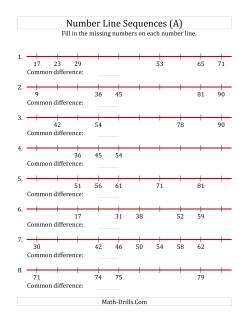
Number lines with missing numbers give students an opportunity to apply some mental math to sequences on a number line. The worksheets below come in different ranges of numbers with larger possible common differences on the worksheets with larger numbers. The custom sequences were based on a user request. The possible common differences are: 2, -2, 5, -5, 20, -20, 25, -25, 100 or -100.
-
Increasing Number Line Sequences (Maximum 10000) Decreasing Number Line Sequences (Maximum 10000) Increasing & Decreasing Number Line Sequences (Maximum 10000) Increasing Number Line Sequences (Custom 1000 to 10000) Decreasing Number Line Sequences (Custom 1000 to 10000) Increasing & Decreasing Number Line Sequences (Custom 1000 to 10000)
Students are asked to draw stars on blank number lines where they would find certain values. For example, they may be asked to place a star where they think 3 would appear on a number line that goes from 0 to 10.
Adding and Subtracting on Number Lines
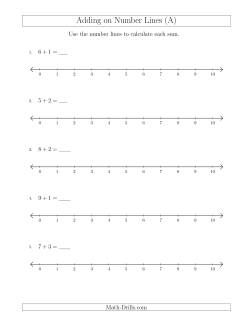
Adding and subtracting on number lines math worksheets allow students to visualize questions by drawing curved paths to numbers.
The basic process for completing addition and subtraction questions on number lines is: (i) start at 0; (ii) draw a curved line from 0 to the first addend or to the minuend (first number in the problem); (iii) draw a second curved line from the first addend/minuend to the answer by the same amount as the second addend or the subtrahend. For subtraction questions, the curved line will go toward 0 while in addition questions, the curved line will continue to go to the right. For example, 4 + 5 = 9 would be shown on a number line with a curved line starting at 0 and ending at 4. A second curved line would start at 4 and end at 9 which would be a total distance of 5 (the second addend). If the question was 17 - 8 = 9, the first curved line would start at 0 and go to 17. The second curved line would start at 17 and end at 9 which is a total of 8 backwards.
Adding with number lines is a way for students to visualize how addition works. Modeling addition on a number line first using an interactive white board or an overhead projector allows students to understand how a number line can be a useful tool for learning addition. The answer keys in the case of these worksheets can be shown to students to start with until they understand how the process works. There are 10 versions of each worksheet below, so you shouldn't run out of practice sheets.
-
Adding up to 20 on Number Lines with Intervals of 2 Adding up to 30 on Number Lines with Intervals of 2 Adding up to 40 on Number Lines with Intervals of 2 Adding up to 50 on Number Lines with Intervals of 5 Adding up to 75 on Number Lines with Intervals of 5 Adding up to 100 on Number Lines with Intervals of 5 Adding up to 100 on Number Lines with Intervals of 10 Adding up to 150 on Number Lines with Intervals of 10 Adding up to 200 on Number Lines with Intervals of 10 Mixed Addition Number Lines (Not for the Faint of Heart)
The subtracting on number lines worksheets are similar to the adding ones, but two different colors are used on the answer keys. When the value is increasing, a green curve is used, and when the value is decreasing, a red curve is used. Hopefully, students associate these two colors with adding and subtracting as they learn how to subtract using a number line.
-
Subtracting from up to 20 on Number Lines with Intervals of 2 Subtracting from up to 30 on Number Lines with Intervals of 2 Subtracting from up to 40 on Number Lines with Intervals of 2 Subtracting from up to 50 on Number Lines with Intervals of 5 Subtracting from up to 75 on Number Lines with Intervals of 5 Subtracting from up to 100 on Number Lines with Intervals of 5 Subtracting from up to 100 on Number Lines with Intervals of 10 Subtracting from up to 150 on Number Lines with Intervals of 10 Subtracting from up to 200 on Number Lines with Intervals of 10 Mixed Subtraction Number Lines (Not for the Faint of Heart)
Additon and subtraction questions are shown on the same worksheet in this section. Once students are familiar with both adding and subtracting using number lines, these worksheets can be used for further practice and to help them pay attention to the operation signs.
-
Adding and Subtracting up to 20 on Number Lines with Intervals of 2 Adding and Subtracting up to 30 on Number Lines with Intervals of 2 Adding and Subtracting up to 40 on Number Lines with Intervals of 2 Adding and Subtracting up to 50 on Number Lines with Intervals of 5 Adding and Subtracting up to 75 on Number Lines with Intervals of 5 Adding and Subtracting up to 100 on Number Lines with Intervals of 5 Adding and Subtracting up to 100 on Number Lines with Intervals of 10 Adding and Subtracting up to 150 on Number Lines with Intervals of 10 Adding and Subtracting up to 200 on Number Lines with Intervals of 10 Mixed Addition and Subtraction Number Lines (Not for the Faint of Heart)
For those students who have mastered the previous worksheets and need a further challenge, these worksheets already have the addition and subtraction curves drawn on the number line and their challenge is to determine the question.
-
Determining Addition and Subtraction Questions from Number Lines up to 10 Determining Addition and Subtraction Questions from Number Lines up to 15 Determining Addition and Subtraction Questions from Number Lines up to 20 Determining Addition and Subtraction Questions from Number Lines where Anything Goes
